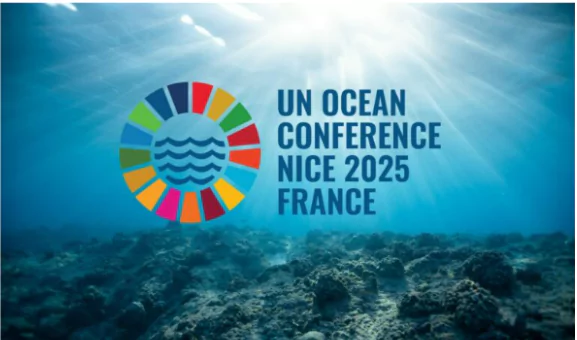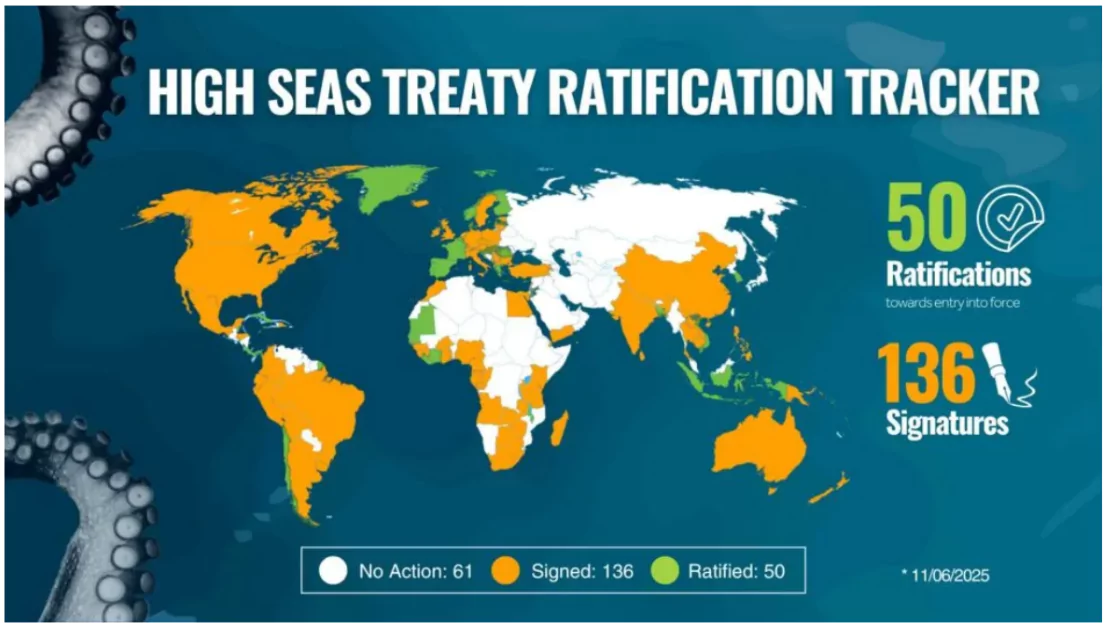The third UN ocean summit in Nice, France concluded with a wave of commitments and a strong call to action to protect marine ecosystems, curb pollution, and secure financing for vulnerable coastal nations.
About the UN Ocean Conference (UNOC3)
- The UN Ocean Conference is a global platform to advance action on ocean conservation.
 Purpose & Objectives: Promote Sustainable Development Goal 14 (SDG 14): “Life Below Water”
Purpose & Objectives: Promote Sustainable Development Goal 14 (SDG 14): “Life Below Water” -
- Address critical ocean threats: Overfishing, pollution (plastic waste), climate change (ocean acidification), and habitat destruction.
- Encourage global partnerships for ocean conservation and sustainable blue economies.
- Organizers & Participants: Co-hosted by the United Nations and member states.
- France and Costa Rica co-hosted the 2025 conference.
- Theme: “Accelerating action and mobilizing all actors to conserve and sustainably use the ocean”
- Focus Areas:
- Marine pollution (especially plastic waste reduction).
- Sustainable fisheries & ending illegal, unreported, and unregulated (IUU) fishing.
- Climate-ocean nexus (mitigating ocean warming & acidification).
- Marine biodiversity conservation (e.g., protecting 30% of oceans by 2030).
- Blue economy (sustainable ocean-based industries).
- Previous and Next Ocean Conferences:
- 2017 (New York): First UN Ocean Conference.
- 2022 (Lisbon): Second UN Ocean Conference.
- UNOC4 (2028): Chile and South Korea will co-host the next summit, aiming to build on progress.
Key outcome of the Conference
- The conference’s outcome, known as the Nice Ocean Action Plan, is a two-part framework that comprises a political declaration and over 800 voluntary commitments.
- Political Declaration: Titled “Our Ocean, Our Future: United for Urgent Action”.
- It reaffirms global commitments to protect 30% of the ocean and land by 2030.
- Aligns with the Kunming-Montreal Biodiversity Agreement, and supports the High Seas Treaty (BBNJ).
- High Ambition Coalition for a Quiet Ocean: Led by Panama & Canada, 37 countries tackling underwater noise pollution.
- Coral Bond: Indonesia and the World Bank launched this innovative financing tool for reef conservation.
- High Seas Treaty (BBNJ): 19 more countries ratified the agreement, bringing total ratifications to 50—just 10 short of the 60 needed for enforcement.
- 800+ Voluntary Commitments: Pledges from governments, NGOs, scientists, and private sectors, ranging from marine protection to sustainable finance.
- Nice Wake-up Call:
- 96 countries have backed the “Nice Wake-up Call,” pushing for an ambitious, legally binding treaty to tackle plastic pollution.
- India is absent from the list, despite claiming to support a binding agreement.
- The statement outlines five essential measures, including reducing plastic production and banning harmful plastics.
- The next round of UN negotiations on Plastic Treaty is set for August 2025 in Geneva.
Key Commitments Announced at the UNOC3

- €1 Billion from the EU: For ocean conservation, research, and sustainable fishing.
- French Polynesia: Plans to create the world’s largest marine protected area (5 million km²).
- Germany’s €100 Million Initiative: To remove underwater munitions in the Baltic and North Seas.
- New Zealand’s $52 Million: To strengthen Pacific Ocean governance.
- Spain’s New Marine Protected Areas: Five new zones to safeguard biodiversity.
The Biodiversity Beyond National Jurisdiction (BBNJ)
- Also called the “High Seas Treaty”, it is a legally binding international agreement under the United Nations Convention on the Law of the Sea (UNCLOS).
- Adopted in 2023, the treaty aims to ensure conservation and sustainable use of marine biodiversity in areas beyond national jurisdiction (covering ~2/3 of the ocean surface).
- Key Provisions of the Treaty:
- Area-Based Management Tools: Includes establishing Marine Protected Areas (MPAs) on the high seas.
- Environmental Impact Assessments (EIAs): Mandatory assessments before activities that could harm high seas ecosystems.
- Marine Genetic Resources & Benefit Sharing: Framework for equitable sharing of benefits derived from marine genetic resources, especially for developing nations.
- Capacity Building & Marine Technology Transfer: Helps developing countries build technical, legal, and scientific capacity.
- Institutional Mechanisms: Includes a Conference of Parties (COP) and scientific/technical bodies to guide implementation.
- Current Status:
- 50 countries ratified (60 needed for the treaty to come into force).
- Takes effect 120 days after the 60th ratification.
- India’s Position:
- Signed in September 2024 but delayed ratification due to pending amendments to India’s Biological Diversity Act and parliamentary approval.
- India emphasizes equitable benefit-sharing of marine resources and supports a legally binding Global Plastics Treaty.
Significance of the Treaty
- The treaty aims to protect 30% of oceans by 2030 (part of the “30×30” target).
- Addresses threats like deep-sea mining, overfishing, and plastic pollution.
- India’s ratification is critical given its strategic interests in the Indian Ocean and leadership in marine conservation.
|
India’s Marine Initiatives:
- Samudrayaan Mission: Plans a 6,000-meter deep-sea manned submersible trial by 2026.
- Blue Economy: Over $80 billion invested in sustainable ocean projects.
- SAHAV Portal: Digital platform for ocean data governance.
|
Challenges Faced by Oceans and Marine Ecosystem
- Rising Sea Temperatures: Global sea surface temperatures hit record highs in 2025, causing widespread coral bleaching and disrupting marine ecosystems.
- The Mediterranean, for example, is warming 20% faster than the global average.
- Ocean Acidification: The ocean absorbs 90% of excess heat and 30% of CO2 emissions, leading to acidification that harms shell-forming organisms like corals and plankton.
- Marine Pollution: Over 8 million metric tons of plastic enter the ocean annually, forming garbage patches and harming marine life through ingestion and entanglement.
- There are nearly 200 trillion pieces of plastic in the ocean and this is expected to triple by 2040 if no action is taken.
- Overfishing and Destructive Practices : Over 60% of global fish stocks are overexploited, with illegal, unreported, and unregulated (IUU) fishing exacerbating the crisis.
- Methods like bottom trawling destroy seabed ecosystems and unintentionally kill non-target species (e.g., turtles, seabirds).
- Biodiversity Loss and Habitat Destruction: Coral reefs, home to 25% of marine species, are dying due to bleaching, with the current event being the worst in recorded history.
- Mangroves and seagrass beds, vital for carbon storage and nurseries for fish, are declining by 7% annually due to urbanization and aquaculture.
- Governance and Funding Gaps: While treaties like the High Seas Treaty (BBNJ) aim to protect international waters, slow ratification (only 50 of 60 needed as of June 2025) delays action.
- SDG 14 (“Life Below Water”) receives less than 0.01% of global sustainability funding, despite oceans contributing $2.5 trillion annually to the economy.
Way Forward and Urgent Actions
- Accelerate Ratification of Key Treaties: Fast-track the High Seas Treaty (BBNJ Agreement), which needs 60 ratifications to enter force (currently 50 as of June 2025).
- Countries like India must prioritize legislative amendments to meet this goal.
- 30×30 Marine Protection Target: Expand Marine Protected Areas (MPAs) to cover 30% of oceans by 2030, focusing on biodiversity hotspots (e.g., coral reefs, mangroves) and enforcing no-take zones.
- Tackle Pollution at Its Source: Enforce bans on single-use plastics and promote circular economies (e.g., reusable packaging).
- Scale innovations like Oman’s empty shipping container reuse platform to reduce maritime waste.
- Promote Sustainable Ocean Economies:
- Blue Food Revolution: Expand restorative aquaculture (e.g., seaweed farming, oyster reefs) to provide protein while rehabilitating ecosystems.
- Invest in blue carbon habitats (mangroves, seagrasses) to sequester CO₂ and buffer coastlines.
- Leverage Technology and Innovation: Deploy AI and drones to track illegal fishing and pollution in protected areas.
- Coral Reef Restoration: Use assisted evolution and 3D-printed reefs to accelerate recovery of climate-resilient corals.
- Empower Communities and Equity: Partner with Indigenous groups (e.g., Canada’s MPAs, Kenya’s women-led fisheries) for locally managed conservation.
Conclusion
The ocean’s health is at a tipping point, but coordinated global action—backed by funding, policy enforcement, and public awareness—can still reverse the damage. Key events like the UN Ocean Conference and COP30 in 2025 are pivotal for turning commitments into tangible progress.
![]() 14 Jun 2025
14 Jun 2025

 Purpose & Objectives: Promote Sustainable Development Goal 14 (SDG 14): “Life Below Water”
Purpose & Objectives: Promote Sustainable Development Goal 14 (SDG 14): “Life Below Water” 
